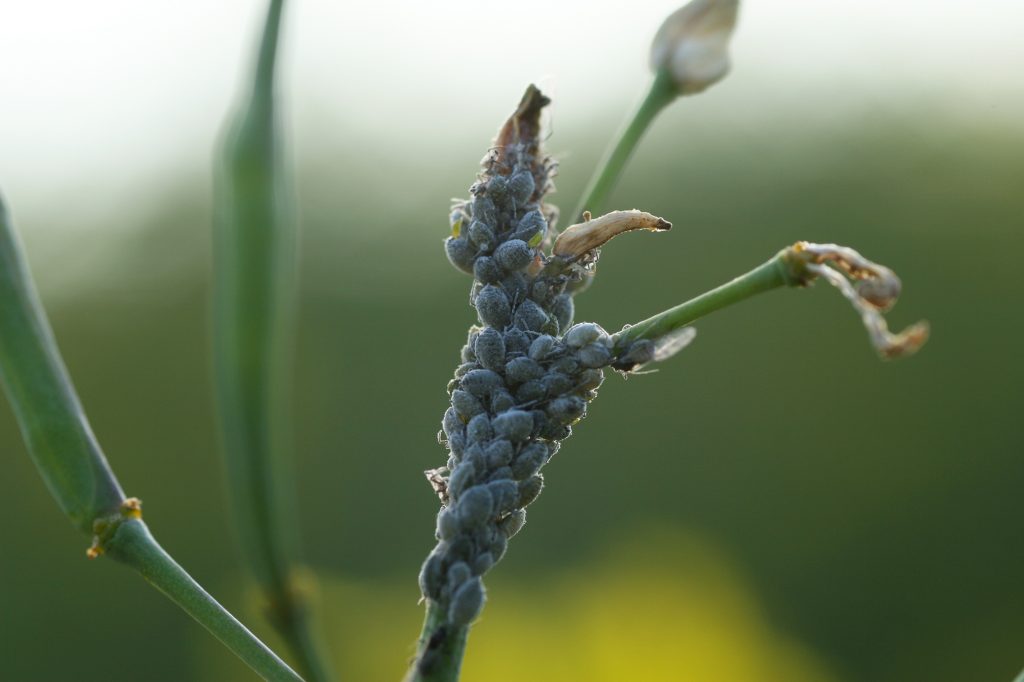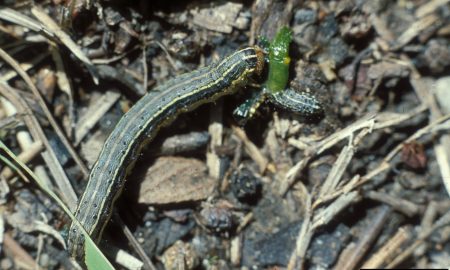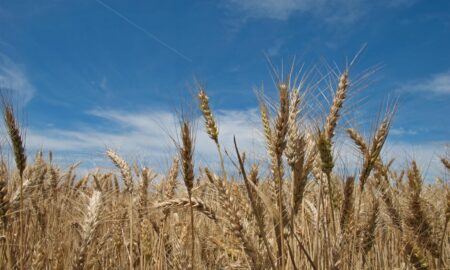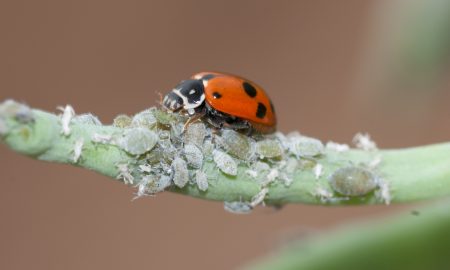With a tendency to colonise the undersides of leaves, green peach aphid is typically not a problem to canola production during spring – however this season they are feeding on stems and pods.
Unusual green peach aphid behaviour
Green peach aphid (GPA, Myzus persicae) has been observed feeding on canola pods and stems in several regions of the NSW Riverina.
Colonies have been observed underneath pods and on stems, and while other canola aphid species are also present (cabbage aphid and turnip aphid) in some cases, there is some concern that green peach aphid could impact grain development.
Similar behaviour has also been seen in canola crops in Victoria’s northern country, where green peach aphid are mostly present in the canopy, but are moving up onto pods as the leaves senesce.
This behaviour is uncommon – when crops are in flower during spring, green peach aphid tend to colonise the underside of leaves and are typically not expected to have an impact on yield.

Photo by Terry Edis 
Photo Andrew Weeks, Cesar Australia
A possible explanation
Pests do behave out of character from time to time. Known as the ‘plant stress hypothesis’, there is evidence that plant moisture stress can increase insect activity and performance on affected crops in some circumstances (Tariq et al. 2012).
For example, one study showed that in the brassica plant Arabidopsis thaliana, green peach aphid population growth was higher in drought-affected plants (Mewis et al. 2012). The authors partly attributed this to changes in sap quality in plants when moisture-stressed.
So, it is quite conceivable that aphids are finding canola pods more attractive than usual given the dry conditions in many regions.
Management considerations
Entomologist Dr Dustin Severtson (DPIRD), has seen green peach aphid colonising canola racemes in dry, warm conditions over the years whilst researching canola aphids.
According to Dr Severtson, the worst cases he has seen during spring is when green peach aphid is infesting canola along with turnip and cabbage aphid, and the plants are very moisture-stressed.
We do not know what impact green peach aphid feeding on canola pods will have and there are no threshold guidelines to guide spray decisions under these conditions.
We do know that canola is more vulnerable to aphid damage at the flowering development stage than at podding, however researchers have seen grain damaged as a result of dense cabbage aphid colonies feeding on pods in moisture-stressed crops. Given this, we cannot assume the impact of green peach aphid feeding on stems and pods will be negligible.
If green peach aphid is present in canola paddocks, please consider the following:
Beneficials are active
During spring, a suite of beneficials are building in crops and will assist with aphid control, including but not limited to parasitic wasps, ladybird beetles, hoverfly larvae, lacewings, damsel bugs, assassin bugs and spiders.
Many beneficial species are highly mobile and will move from crop to crop if left unsprayed.
Monitor crops regularly enough so you can measure whether the relative rate of increase in beneficial insects (per sweep, per m, etc.) is faster (or slower) than that of pest populations. If the former is the case, the beneficials are getting ahead.
With respect to parasitic wasp activity, keep in mind that when an aphid host takes on the typical aphid mummy appearance, wasp development is almost complete. So, the level of parasitism in a crop is higher than what can be seen by eye.
Chemical control options are very limited
Due to insecticide resistance, chemical options for green peach aphid control are very limited in late-stage canola crops.
cesar research has found that > 90% of all green peach aphid populations collected from canola crops across Australia are highly resistant to synthetic pyrethroids (e.g. alpha-cypermethrin) and carbamates (e.g. pirimicarb). Applications of these chemicals, even at very high rates, will not control green peach aphid if these resistances are present.
The vast majority of green peach aphid populations also possess resistance to organophosphates (e.g. dimethoate). However, the mechanism underlying this resistance is unusual in that it can be ‘switched on’ in response to particular stressors. Additionally, the level of resistance is much lower than for pyrethroids and carbamates.
Although risky, this means organophosphates can be effective in some instances. Anecdotal evidence suggests green peach aphid numbers can be reduced by up to 50% despite the presence of organophosphate resistance, although complete control failures have been known to occur (so there are no guarantees!).
Sulfoxaflor (Transform) is effective against green peach aphid, however it cannot be used on canola past full flower.
Paraffinic oils are also registered against green peach aphid in canola, however these sprays will only suppress populations. Oils have the advantage of being soft on beneficial populations and have very short withholding periods.
Who is the main culprit?
If you have large colonies of aphids on canola racemes and have a mix of species, it is important to correctly identify the main culprit.
Turnip aphid and cabbage aphid are common on stems and pods during spring and aren’t resistant to registered chemistries. If either of these two species are present and in large numbers, we recommend the use of pirimicarb as it is softer on beneficials.
The current threshold for cabbage aphid and turnip aphid is >20% of plants infested with colonies, however the research conducted for this threshold was with growth stages prior to advanced podding, and it is critical to consider several other factors before making a decision. Most importantly, the current growing conditions and moisture availability should be assessed.
Crops that are not moisture-stressed have a greater ability to compensate for aphid damage and can tolerate higher infestations than moisture-stressed plants before yield loss occurs.
Aphid numbers will crash naturally
Rain, particularly heavy rainfall events, will impact green peach aphid populations by physically dislodging them from plants. This is more likely where aphids are located on the pods and stems (as opposed to the leaves), as is presently the case in many regions.
Rain can also promote the growth of entomopathogenic fungi which kills aphids, however this is unlikely to be abundant given the dry weather conditions this year.
As the canola seed develops and ripens and pods begin to senesce, they quickly become unfavourable for aphids as they are less able to probe the plant’s tissues.
At this time, aphids die out very quickly (or move on to other crops) and management actions are not necessary.
Field reports suggest green peach aphid numbers have plummeted in some canola crops in the past week.
Acknowledgements
Thanks to Dr Dustin Severtson (DPIRD) for his assistance in developing this article.
Field observations
Terry Edis, Elders (Riverina NSW)
Bruce Larcombe, Larcombe Agronomy (Northern Country VIC)
Emma Robinson, Landmark (Riverina NSW)
Greg Sefton, Sefton Agronomics (Riverina NSW/Northern Country VIC)
Further reading
Resistance management strategy for green peach aphid (GPA) in Australian grains
Green peach aphid – PestFacts southern
References
Mewis I, Khan MAM, Glaswischnig E, Schreiner M & Ulrichs C (2012). Water stress and aphid feeding differentially influence metabolite composition in Arabidopsis thaliana (L.), PLOS ONE 7(11): e48661.
Tariq M, Wright DJ, Rossiter JT & Staley JT. (2012). Aphids in a changing world: testing the plant stress, plant vigour and pulsed stress hypotheses. Agricultural and Forest Entomology 14: 177-182.
Cover image: Photo by Andrew Weeks, Cesar Australia





